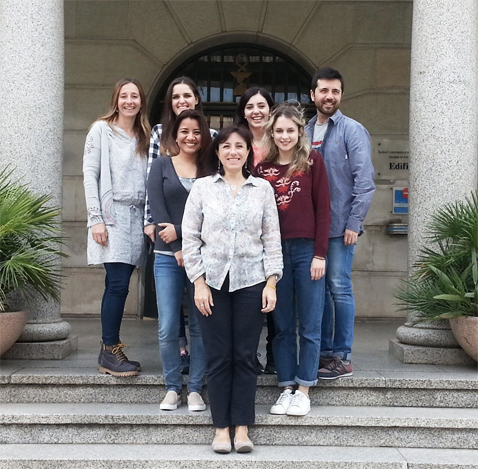
MERCÈ PALLAS LLIBERIA
Position: Professor
Research team
Anna Maria Canudas Teixido
Associate Professor
canudas(a)ub.edu
Christian Griñan Ferre
Postdoctoral researcher
Vanesa Izquierdo Cadenas
Early stage researcher
Veronica Palomera Avalos
Early stage researcher
veropalomera(a)ub.edu
M. Dolors Puigoriol Illamola
Early stage researcher
Foteini Vasilopoulou
Early stage researcher
Coral Sanfeliu
Collaborator
Contact details
Prof. Merce Pallas Lliberia
Department of Farmacologia, Toxicologia i Química Terapèutica
Faculty of Pharmacy and Food Sciences. Av. Joan XXIII, 27-31.
08028 Barcelona (Spain)
34 934024531
pallas (at) ub.edu
Research Interests
The aim of the last years research is centered in brain senescence and Alzheimer’s disease, both in studying molecular mechanisms gated to this deleterious process as well as to study non pharmacological (exercise, caloric restriction) and pharmacological (melatonin, resveratrol, new chemical entities) strategies to ameliorate and to prevent them with a special focus on the role of sirtuin 1 in inflammaging.
As applicative follow out of its research, group is currently interested in identification of new target to achieve preventive or curative strategies by reducing inflammation, mitochondrial and endoplasmic reticulum stress, oxidative stress in pathological senescence and the crossroad with epigenetics. The research conducted in recent years by the research group has been focused primarily on the SAMP8 model (senescence accelerated mouse) strain prone to early aging and sporadic AD and in transgenic AD models.
SAMP8 compared to SAMR1 (control strain) have a number of significant changes: increase of oxidative stress and inflammaging, Tau Hyperphosphorylation, and CDK5 and GSK3-ß activation; Abnormal APP processing; Sirtuin 1 and other HDAC alterations; and neuroinflammation processes as earlier as 1 month. We demonstrated that dietary resveratrol in SAMP8 increased survival by activating AMPK pathways and pro-survival routes such as SIRT1, reducing cognitive impairment. Moreover, resveratrol treatment in APP/PS1 mice significantly delayed memory loss measured by the NORT, reduced the amyloid burden and increased mitochondrial complex IV protein levels in brain. Results published also demonstrated that during SAMP8 senescence process there are epigenetic and autophagy mechanisms that could be under the accelerated ageing, and that these processes are modulated by environmental factors, as exercise. Recently we have initiated a new pipeline on new chemical entities acting in putative new targets implicated in neuroinflammation and neurodegeneration in collaboration with Dr Vazquez and Dr Escolano from University of Barcelona. This new line implicated to test cognitive effects of new compounds, target engagement, PK/PD analysis (by External collaborations) and molecular and biochemical studies to demonstrate efficacy in neuroprotection.
In the last years, the group collaborated with groups of the University of Kent (Ohio, USA), National Institute on Aging, Baltimore (MD, USA), Universidad de Guadalajara (Mexico), Universitat Autonoma de Barcelona, Universidad de Granada, Universidad de La Laguna, Universidad de Oviedo, CSIC-IDIBABS and with the company Oryzon Genomics.
Current Research Lines
- Senescence
- Alzheimer’s disease
- Neuroinflammation
- Neuroprotection
- Epigenetic control of neurodegeneration
Technologies / methods
- Molecular biology standard methodologies: protein levels determination, gene transcription quantification, Inmunohistochemical methodology, confocal microscopy.
- Cognitive test: learning, memory and BSPD.
Highlighted publications
· Griñan-Ferré C, Pérez-Cáceres D, Gutiérrez-Zetina SM, Camins A, Palomera-Avalos V, Ortuño-Sahagún D, Rodrigo MT, Pallàs,M. Title: Environmental Enrichment Improves Behavior, Cognition, and Brain Functional Markers in Young Senescence-Accelerated Prone Mice (SAMP8). Molecular Neurobiology 2015: 53(4):2435-50.
· Griñan-Ferré, C; Sarroca, S; Ivanova, A.; Camins, A; Sanfeliu, C; Pallas, M. Epigenetic mechanisms underlying cognitive impairment and Alzheimer’s disease hallmarks in 5XFAD mice. Aging-US. 2016; 8(4):664-84)
· V. Palomera-Avalos, C. Griñán-Ferré, D. Puigoriol-Ilamola, A. Camins, C. Sanfeliu,A. M. Canudas, M. Pallàs Resveratrol Protects SAMP8 Brain Under Metabolic Stress: Focus on Mitochondrial Function and Wnt Pathway Molecular Neurobiology 54(3):1661-1676
· Griñan-Ferré C, Puigoriol-Illamola D, Palomera-Ávalos V, Pérez-Cáceres D, Companys-Alemany J, Camins A, Ortuño-Sahagún D, Rodrigo MT, Pallàs M.Environmental Enrichment Modified Epigenetic Mechanisms in SAMP8 Mouse Hippocampus by Reducing Oxidative Stress and Inflammaging and Achieving Neuroprotection. Front Aging Neurosci. 2016 8;8:241.
· Leiva R, Griñan-Ferré C, Seira C, Valverde E, McBride A, Binnie M, Pérez B, Luque FJ, Pallàs M, Bidon-Chanal A, Webster SP, Vázquez S. Design, synthesis and in vivo study of novel pyrrolidine-based 11β-HSD1 inhibitors for age-related cognitive dysfunction. Eur J Med Chem. 2017 Oct 20;139:412-42


